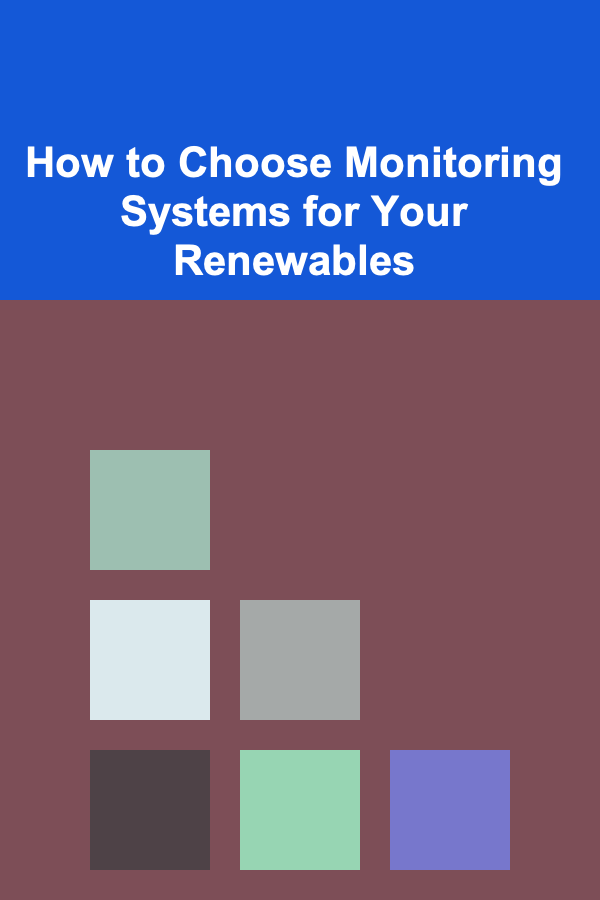
How to Choose Monitoring Systems for Your Renewables
ebook include PDF & Audio bundle (Micro Guide)
$12.99$5.99
Limited Time Offer! Order within the next:

As the world transitions towards more sustainable and environmentally-friendly energy sources, renewable energy has emerged as the front-runner in mitigating climate change. Wind, solar, hydroelectric, and other renewable energy sources are becoming critical components of the global energy mix. However, with the increase in the use of renewable energy technologies comes the necessity to ensure their efficient operation and optimal performance. This is where monitoring systems for renewable energy (RE) systems play an essential role. Monitoring systems provide real-time data and insights into the performance of renewable energy installations, ensuring their reliability, cost-effectiveness, and longevity.
In this article, we will explore how to choose monitoring systems for your renewable energy installations. We will cover the importance of monitoring, the different types of monitoring systems available, their features, and the factors to consider when selecting a system. By the end of this guide, you should have a clearer understanding of how to select the ideal monitoring solution that fits the specific needs of your renewable energy project.
Why Monitoring Systems are Essential for Renewables
The integration of renewable energy sources into the grid presents new challenges that are different from traditional energy generation methods. Variability in energy production, grid integration, weather dependence, and system reliability are all factors that require ongoing monitoring and analysis. Here are some reasons why monitoring systems are essential:
1. Real-time Performance Data
Monitoring systems enable operators and stakeholders to track the real-time performance of renewable energy systems. By continuously analyzing data, these systems can provide insights into how efficiently the system is generating energy, identifying trends, and highlighting issues before they become critical problems.
2. Maximized Efficiency and Performance
The ultimate goal of any renewable energy installation is to maximize energy production while minimizing operational costs. Monitoring systems can help identify underperforming equipment, system inefficiencies, and energy loss areas, allowing for prompt corrective actions. This results in increased energy yield and a better return on investment.
3. Proactive Maintenance and Early Fault Detection
Early fault detection is vital to maintaining the longevity and optimal performance of renewable systems. Monitoring systems offer alerts and diagnostics that notify operators when something is wrong or when a piece of equipment needs maintenance. This reduces the need for expensive repairs and downtime.
4. Compliance and Reporting
For regulatory and financial reasons, many renewable energy systems must comply with environmental and grid performance standards. Monitoring systems help in collecting the necessary data for compliance and generating the required reports, which can be submitted to governing bodies or stakeholders.
5. Remote Access and Monitoring
In the case of large-scale or offshore renewable energy projects, on-site monitoring might be impractical. Monitoring systems enable remote access, allowing operators to manage and troubleshoot systems from anywhere in the world.
Types of Monitoring Systems for Renewables
The types of monitoring systems vary depending on the renewable energy source, the size of the system, and the desired capabilities. Broadly, they can be divided into two categories: centralized and decentralized monitoring systems.
1. Centralized Monitoring Systems
A centralized monitoring system involves gathering data from various renewable energy assets (e.g., solar panels, wind turbines, or hydroelectric generators) into one central platform. This allows for easier management and control of multiple assets from a single point.
Pros:
- Simplified Management: A single platform for all monitoring data makes it easier for operators to monitor multiple installations.
- Centralized Reporting: Aggregated data can be easily analyzed, and reports can be generated for various stakeholders.
- Cost-Effective for Large Systems: For large-scale installations, centralized systems can reduce the complexity of monitoring each unit individually.
Cons:
- Single Point of Failure: If the centralized system experiences an outage, it could impact the monitoring of all assets.
- Limited Customization: While they are designed to handle large amounts of data, they might not offer as much customization as decentralized systems.
2. Decentralized Monitoring Systems
Decentralized monitoring systems collect and process data from individual renewable energy assets independently. Each asset (e.g., a solar panel, wind turbine, or inverter) has its own monitoring system that works separately from the others. Data from each unit is sent to the central database for aggregation.
Pros:
- Redundancy: Since each asset is monitored independently, the failure of one monitoring system doesn't impact the others.
- Granular Data: More detailed data is available for individual assets, which can lead to more specific maintenance actions.
- Flexible Configuration: You can install and configure monitoring systems based on the specific needs of each asset.
Cons:
- More Complex Management: Managing a decentralized system with multiple points of data collection can be complex, especially if there are numerous assets.
- Higher Costs for Small Projects: Smaller installations might not benefit from the complexity of a decentralized system, making them more expensive compared to centralized options.
3. Hybrid Monitoring Systems
A hybrid system combines the features of both centralized and decentralized systems. This system enables real-time data collection at the asset level while allowing centralized analysis and management of the data.
Pros:
- Flexible and Robust: A hybrid approach can combine the benefits of centralized and decentralized systems, offering redundancy while simplifying overall management.
- Scalable: Hybrid systems can easily scale to accommodate both small and large installations.
Cons:
- Complex Setup and Maintenance: Hybrid systems require integration of both centralized and decentralized components, which can be complex to configure and maintain.
- Higher Initial Investment: A hybrid system requires a larger upfront investment compared to simple centralized systems.
Key Features to Look for in Renewable Energy Monitoring Systems
When selecting a monitoring system for your renewable energy installation, there are several key features to consider. These features will ensure that the monitoring system meets your operational needs, compliance requirements, and budget constraints.
1. Real-Time Data Acquisition
The most important feature of a monitoring system is its ability to capture and transmit real-time data from renewable energy assets. This includes energy output, performance metrics, environmental conditions, and any faults or anomalies.
2. Data Visualization and Dashboards
A good monitoring system will present data in an easy-to-understand format, often through visual dashboards. These dashboards allow operators to view data from multiple sources in one place, enabling quick decision-making.
3. Predictive Analytics and Machine Learning
Modern monitoring systems incorporate predictive analytics and machine learning algorithms to forecast potential issues, optimize performance, and provide insights into future energy production. These capabilities help operators plan maintenance schedules, troubleshoot problems before they arise, and enhance the performance of renewable assets.
4. Remote Access and Control
Remote access allows operators to monitor and control systems from anywhere, which is particularly valuable for offshore, remote, or large-scale installations. Many systems now include mobile apps or cloud-based interfaces that provide remote monitoring capabilities.
5. Integration with Other Systems
Renewable energy installations often involve a range of other systems, such as energy storage, grid management systems, or building management systems (BMS). Your monitoring system should be able to integrate seamlessly with these other systems to provide a comprehensive view of your energy infrastructure.
6. Data Logging and Reporting
Accurate data logging and automated reporting features are essential for meeting regulatory compliance, ensuring transparency, and facilitating financial audits. Reports should be customizable and capable of being generated at specified intervals.
7. Fault Detection and Diagnostics
A robust fault detection system is critical to the reliability of renewable energy systems. Monitoring systems should include alarms and notifications for real-time error reporting, which can help in early fault detection and reduce downtime.
8. Security
Security features are crucial, especially when dealing with data that is transmitted over networks. Look for monitoring systems that offer encryption, multi-factor authentication, and secure data storage to protect sensitive information.
Factors to Consider When Choosing a Monitoring System
1. System Size and Complexity
The size and complexity of your renewable energy installation will play a significant role in determining the best monitoring system. Smaller systems with fewer assets may benefit from simpler, more cost-effective centralized monitoring solutions, while larger systems may require more robust decentralized or hybrid systems.
2. Budget
Consider both the initial and ongoing costs of the monitoring system. While high-end monitoring systems offer more advanced features, they might not be necessary for smaller installations. Evaluate the trade-off between cost and features to select a solution that provides value without exceeding your budget.
3. Scalability
As your renewable energy system grows, so should your monitoring system. Ensure that the monitoring solution you choose is scalable and can handle additional assets or larger data volumes as your system expands.
4. Compliance Requirements
Ensure that the monitoring system complies with any regulatory standards for reporting and data collection specific to your location or industry. Monitoring systems should be capable of producing reports that meet legal and financial requirements.
5. Support and Maintenance
Choose a monitoring system provider that offers reliable customer support and easy-to-understand documentation. In addition, check if the system includes a maintenance package, software updates, and troubleshooting support.
6. User-Friendliness
The system should be user-friendly, allowing operators to access and interpret data without needing extensive training. A system that offers intuitive interfaces, automated reports, and easy troubleshooting will save time and resources in the long run.
Conclusion
Selecting the right monitoring system for your renewable energy project is crucial for ensuring the success of your installation. A well-chosen system can improve performance, enhance reliability, lower maintenance costs, and help meet compliance standards. By evaluating the specific needs of your installation, considering the key features mentioned, and understanding your operational objectives, you can make an informed decision on the best monitoring solution.
Remember that the renewable energy sector is evolving rapidly, and so are monitoring technologies. Keeping up with the latest advancements and selecting a system that aligns with your long-term goals will ensure your renewable energy project remains efficient and sustainable for years to come.
Reading More From Our Other Websites
- [Organization Tip 101] How to Arrange Furniture for Better Flow in Your Dining Room
- [Home Maintenance 101] How to Prevent and Maintain Your Home from Water Damage
- [Biking 101] How to Recover from Cycling Injuries and Get Back on Track
- [Tie-Dyeing Tip 101] Turn Old Clothes into Art: Eco‑Friendly Tie‑Dye Projects for Skill‑Building
- [Personal Finance Management 101] How to Invest in Cryptocurrency Responsibly (for Beginners)
- [Organization Tip 101] How to Utilize Old Furniture for Craft Supply Storage
- [Organization Tip 101] How to Tackle Closet Overwhelm Step by Step
- [Scrapbooking Tip 101] Best Scrapbooking Ideas for Documenting a Home Renovation Project
- [Needle Felting Tip 101] Mastering the Basics: Essential Needle Felting Techniques for Beginners
- [Organization Tip 101] How to Use Color Coordination for Seasonal Clothing

Becoming a Successful Community Outreach Coordinator: Essential Skills for Engaging Communities
Read More
How to Avoid Over-lighting Your Home and Create a Balanced Effect
Read More
How to Create a Kid-Friendly Snack Zone in the Kitchen
Read More
How to Use Labels to Keep Your Hobby Collection Organized
Read More
Maximizing Your Adventures: A Deep Dive into Attraction Discount Cards
Read More
10 Tips for Negotiating Lower Bills and Saving Money
Read MoreOther Products

Becoming a Successful Community Outreach Coordinator: Essential Skills for Engaging Communities
Read More
How to Avoid Over-lighting Your Home and Create a Balanced Effect
Read More
How to Create a Kid-Friendly Snack Zone in the Kitchen
Read More
How to Use Labels to Keep Your Hobby Collection Organized
Read More
Maximizing Your Adventures: A Deep Dive into Attraction Discount Cards
Read More